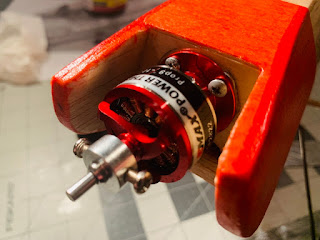Covering
Fuselage
The fuselage received two coats of Sanding Sealer with light sanding using a 400 grit paper before each coat . After the first two coats I applied the orange Silk Span trim patterns. I wet the orange Silk Span with water from a spray bottle, positioned it carefully, and removed any trapped air bubbles. Once satisfied, I applied Sanding Sealer to the orange Silk Span to fix it in place. When dry, I ran another light sanding of the entire fuselage and applied the final coat of Sealer.
Wings
I followed the test covering process I did on the balsa frame and covered the wings with clear (white) Silk Span. Once the edges where dry, I followed with light sanding and a coat of Sealer. I added the orange color trim following the 1963 patterns. Just like the fuselage trim, I wet the Silk Span trips, laid them down on the wing, and fixed them in place with a coat of sealer.
Once the sealer over the trim was dry, I lightly sanded the wings and applied the final coat over the entire wing surface.
The wing weight increase after covering and Sealer was as follows:
Top wing:
- No covering: 50 grams
- Silk span only: 59 grams
- Fist coat and trim: 66 grams
- Final Sealer coat: 70 grams
Bottom wing:
- No covering: 27 grams
- Silk span only: 34 grams
- Fist coat and trim: 37 grams
- Final Sealer coat: 39 grams
The end result.












Comments
Post a Comment